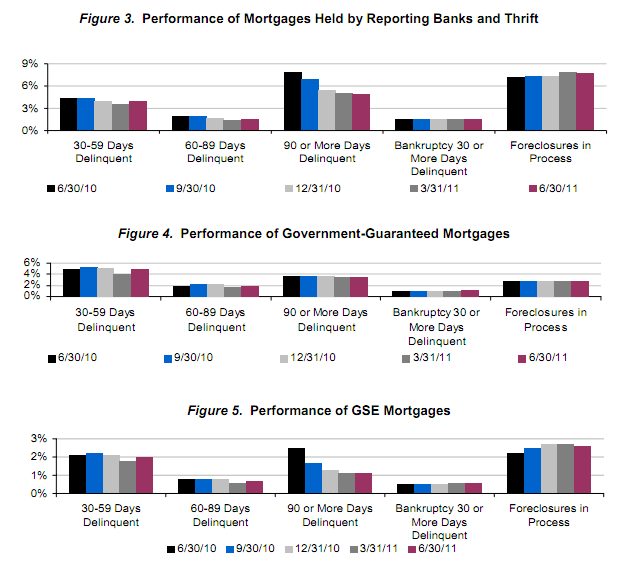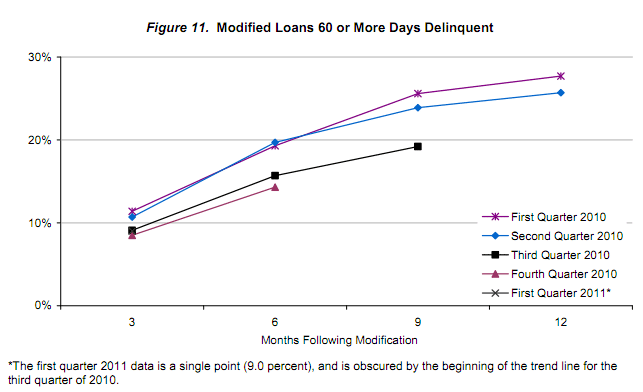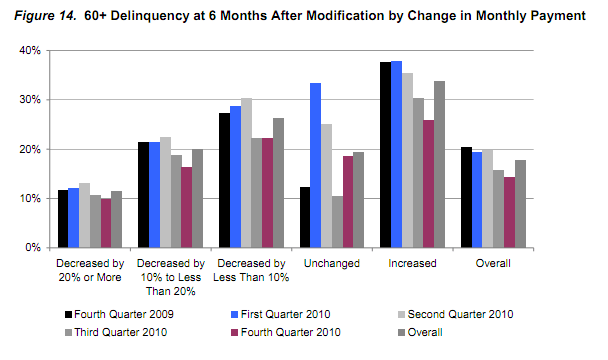The eight national banks and single federal savings association servicing the largest loan portfolios reported that first mortgage performance declined across all categories of delinquencies during the second quarter of 2011. The information is part of the Office of Comptroller of the Currency (OCC) Mortgage Metrics Report released on Thursday which covers 63 percent of all outstanding first mortgages in the nation.
According to the report, current and performing loans represented 88.6 percent of the banks' portfolios in the first quarter but declined to 88 percent by the end of the second quarter. This is still an improvement from the second quarter of 2010 when 87.3 percent of the loans in the portfolios were current.

Similar to the overall portfolio of mortgages, the performance of mortgages held by reporting banks and thrift declined in the second quarter of 2011 to an 80.3 percent ratio of current and performing loans, down from 80.4 percent the previous quarter but up from 77.2 percent a year ago. The percentage of performing government guaranteed mortgages decreased to 85.7 percent from 87.0 percent in Q1 but was improved from 85.3 one year ago. Freddie Mac and Fannie Mae mortgages perform better than the overall portfolio because of a higher percentage of prime loans. Current and performing loans constituted 93.1 percent at the end of Q2 compared to 93.2 percent at the end of Q1 and 92 percent in Q1 2010.

Early stage delinquencies, i.e. mortgages that are 30 to 59 days delinquent, increased from 2.6 percent of the portfolio in the first quarter to 3 percent, reflecting seasonal effects in addition to the sluggish economy and elevated unemployment. Seriously delinquent mortgages - those over 60 days delinquent and delinquent mortgages held by bankrupt borrowers, increased one basis point to 4.9 percent of the portfolio, ending five straight quarters when this category trended down. Both early stage and serious delinquencies were down from a year earlier by .9 percent and 19.9 percent respectively.
The percentage of mortgages in the process of foreclosure was unchanged at 4 percent of the total portfolio and while completed foreclosures increased 1.2 percent quarter-over-quarter, the numbers were down more than 30 percent from the second quarter of 2010. While the yearly decrease was significant, OCC warned that completed foreclosures may continue to increase in future quarters as a large number of delinquent loans work through the process and borrowers exhaust other alternatives.
Short sales increased by 12.6 percent during the second quarter and now represent 31 percent of all home forfeiture actions. Deeds-in-lieu increased by almost 50 percent but still represent less than 1 percent of home forfeitures.
Servicers implemented 456,397 home retention actions during the quarter, nearly twice the 287,145 new foreclosure proceedings. Most of these actions were under the Home Affordable Modification Program (HAMP) which increased by 31.6 percent during the quarter while other actions were down. The net result was a decrease of 18.1 percent in new retention actions compared to the first quarter. Servicers have modified 2,083,464 mortgage loans from the beginning of 2008 through the end of the first quarter of 2011.
There has been increasing success with these modification efforts. Mortgages modified in recent quarters have improved steadily over earlier modifications and have performed consistently better than has been historically the case for such loans. At the end of the second quarter of 2011, 51.3 percent of modifications remained current or had been paid off. Another 9.2 percent were 30-to-59 days delinquent, and 18.2 percent were seriously delinquent. More than 10 percent were in the process of foreclosure and 5.3 percent had completed the foreclosure process. Of the 938,180 modifications implemented during 2010, 62.4 percent were current or paid off. Another 10.4 percent were 30-to-59 days delinquent, 15.2 percent were seriously delinquent, and 8.4 percent were in the process of foreclosure or had completed the foreclosure process. The table below shows the steadily improving performance metrics of modified loans over the last five quarters.

The on-going emphasis on sustaining
the modifications by lowering the monthly payment is apparently paying off in
reduced defaults. As the figure below
shows, as the amount of the payment reduction increases, the default rate
consistently goes down.

Modifications done under HAMP are performing much better than those done under other auspices. A chart comparing the performance of HAMP modifications with other modifications done in the last five quarters at three month intervals results in 14 cohorts. HAMP modifications significantly outperformed other modifications in all but the three month data point for loans modified in Q4 2010. That deficiency was overcome three months later.







